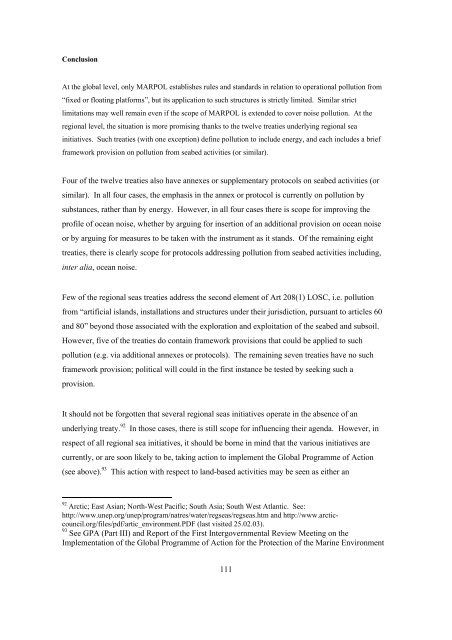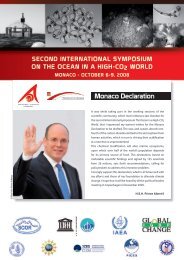Oceans of noise - Whale and Dolphin Conservation Society
Oceans of noise - Whale and Dolphin Conservation Society
Oceans of noise - Whale and Dolphin Conservation Society
- No tags were found...
Create successful ePaper yourself
Turn your PDF publications into a flip-book with our unique Google optimized e-Paper software.
ConclusionAt the global level, only MARPOL establishes rules <strong>and</strong> st<strong>and</strong>ards in relation to operational pollution from“fixed or floating platforms”, but its application to such structures is strictly limited. Similar strictlimitations may well remain even if the scope <strong>of</strong> MARPOL is extended to cover <strong>noise</strong> pollution. At theregional level, the situation is more promising thanks to the twelve treaties underlying regional seainitiatives. Such treaties (with one exception) define pollution to include energy, <strong>and</strong> each includes a briefframework provision on pollution from seabed activities (or similar).Four <strong>of</strong> the twelve treaties also have annexes or supplementary protocols on seabed activities (orsimilar). In all four cases, the emphasis in the annex or protocol is currently on pollution bysubstances, rather than by energy. However, in all four cases there is scope for improving thepr<strong>of</strong>ile <strong>of</strong> ocean <strong>noise</strong>, whether by arguing for insertion <strong>of</strong> an additional provision on ocean <strong>noise</strong>or by arguing for measures to be taken with the instrument as it st<strong>and</strong>s. Of the remaining eighttreaties, there is clearly scope for protocols addressing pollution from seabed activities including,inter alia, ocean <strong>noise</strong>.Few <strong>of</strong> the regional seas treaties address the second element <strong>of</strong> Art 208(1) LOSC, i.e. pollutionfrom “artificial isl<strong>and</strong>s, installations <strong>and</strong> structures under their jurisdiction, pursuant to articles 60<strong>and</strong> 80” beyond those associated with the exploration <strong>and</strong> exploitation <strong>of</strong> the seabed <strong>and</strong> subsoil.However, five <strong>of</strong> the treaties do contain framework provisions that could be applied to suchpollution (e.g. via additional annexes or protocols). The remaining seven treaties have no suchframework provision; political will could in the first instance be tested by seeking such aprovision.It should not be forgotten that several regional seas initiatives operate in the absence <strong>of</strong> anunderlying treaty. 92 In those cases, there is still scope for influencing their agenda. However, inrespect <strong>of</strong> all regional sea initiatives, it should be borne in mind that the various initiatives arecurrently, or are soon likely to be, taking action to implement the Global Programme <strong>of</strong> Action(see above). 93 This action with respect to l<strong>and</strong>-based activities may be seen as either an92 Arctic; East Asian; North-West Pacific; South Asia; South West Atlantic. See:http://www.unep.org/unep/program/natres/water/regseas/regseas.htm <strong>and</strong> http://www.arcticcouncil.org/files/pdf/artic_environment.PDF(last visited 25.02.03).93 See GPA (Part III) <strong>and</strong> Report <strong>of</strong> the First Intergovernmental Review Meeting on theImplementation <strong>of</strong> the Global Programme <strong>of</strong> Action for the Protection <strong>of</strong> the Marine Environment111




